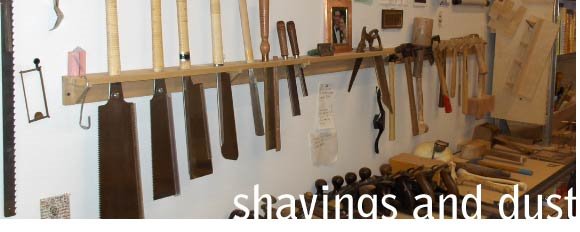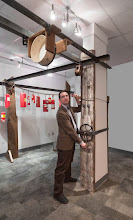I needed lumber for the table, so I went to Brooklyn Restoration Supply. Which is in Brooklyn, Connecticut, of course.
Two massive long barns sit on a hill with an open space in between. Both structures are in the last stages of decrepitude, the stages that immediately precede being called a "ruin." They both have several layers of asphalt shingles nailed to them in no particular order, and when you look closely, you can see them peeling away, exposing other layers underneath, like huge, moldy leaves of an onion, describing decades of patching and hoping.
One barn has doors and shutters and windows and railings and balusters. Hundreds and hundreds of them, all stacked into two floors of dim, musty smell. Here is a stack of 30 green shutters, for example, leaning on a stack of 10 red ones, carefully kept in batches, waiting for someone with just the right windows to come and give them a new purpose. Balusters from hundreds of long-gone staircases are bundles with twine, standing in barrels and on the floor, next to handrails stacked like cordwood, the delicately curved ends all sticking out like tendrils on some massive wooden plant. One day, each handrail hopes, someone will come and buy them and take them back to a well-lit home where children can again screech with glee as they slide from floor to floor.
The other barn is where the reclaimed wood is. Oak and chestnut and pine, mostly. Some long-leaf, some douglas fir. Stacks as high as my head, and thirty feet long. Floorboards and clapboards and barn siding, many planks show paint that hint at their former life, occasionally showing the outline of an appliance, or the presence of long-lost moulding.
This whole kingdom of ghosts of memories is presided over by Rudy. I do not know his last name, he is just Rudy. About five foot nothing, and the type of octogenarian that is called "sprightly." Slender. Moves pretty fast for an old guy. And he is an old guy. Impossible to tell how old, but eighty is probably good for a guess. His eyes are completely shrouded by two luxuriously massive eyebrows, the kind that look like they might leap off his face and attack you if you are not careful. As he walks around, he sucks constantly at an old pipe. The wooden bowl long ago came loose, and is held to the stem now only by several wraps of black electrical tape. He only removes the pipe from his mouth to gesticulates with it, as in "the chestnut is over here (gestures with pipe) and the oak is mostly up there."
Today, I decided, I would look for oak. He took me up to the second floor and showed the the stacks and stacks of oak and then wandered off, leaving me to pick through and find the right pieces for the table.
This is not a short process.
Every piece gets pulled off the pile, set next to other pieces, and contemplated. Sometimes, they are very clear about not wanting to be together. Other times it is a little more ambiguous, and has to be set aside temporarily while other combinations are examined. This is a very important moment, because these old cantankerous pieces of oak will be living next to each other for a long time to come, and they need to be able to tolerate each other. They need to look good together. There is a lot of listening going on on the second floor of the lumber barn. I had in mind that the top would be two planks wide, and that there would be a little gap running down the center, which would be the found edge of the board, so that there would be a constant reminder of the history of the wood. And, me being me, I wanted the two planks to be of the same width, so that the gap would be dead in the center.
Sometimes, I have to remember to give up my obsessive need for symmetry.
After much picking and looking, I found some great, old wide planks. Old floor boards. They will do very nicely, I think, and so far are content to live out the next chunk of their lives together. They are not the same width, so the gap will be a little off center, but then, I kind of like that. Nothing in nature is 100% symmetrical, after all, and there is no good reason the table should be, either.
For leg stock I went down to the first floor, where the salvaged timbers are kept. These are massive framing members from old barns, eight or ten inches square, many with the marks of axes and adzes visible. They are from a time when logs were squared by hand and mortised and tennoned into frames for barns and houses. and now they are piled here in a Brobdingnaginan pick-up-stick pile. Back over in the corner was the beam I needed for the legs. Five foot long and about seven inches square, it has a mortise cut in it that has the augur holes at the bottom and the layout lines still visible on the surface. I can watch the carpenter laying out the mortise and cutting it, he is still here, bending over his work as I watch, even though we are separated by a hundred years or more.
So all of this gets lugged outside. Rudy ambles over, lighting his pipe on the way, and inspects the find.
"That's it, is it?"

"For today it is."
"Well, let's get you measured." Out comes a tape measure and there is a checking and a rechecking. Some math is scribbled on the nearest flat surface, a door with peeling yellow paint and fifteen or twenty similar math problems on its panels. Into the Cruiser it goes for the trip back to Rhode Island.
Now the lumber is standing against the wall in the studio, waiting to begin the next phase of its life. It seems so much bigger in this context than when thrown amongst a jumble of other boards. But soon, probably after the new year, it will begin the process of becoming a new table. I can't wait.


1 comment:
WOW. Wow. Just...wow.
Post a Comment